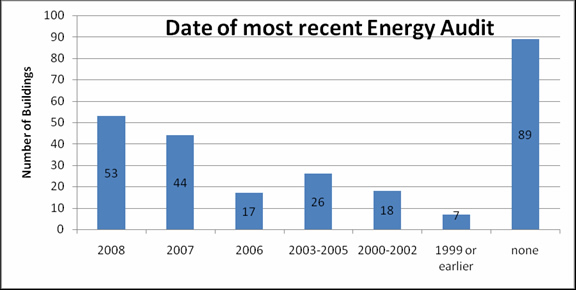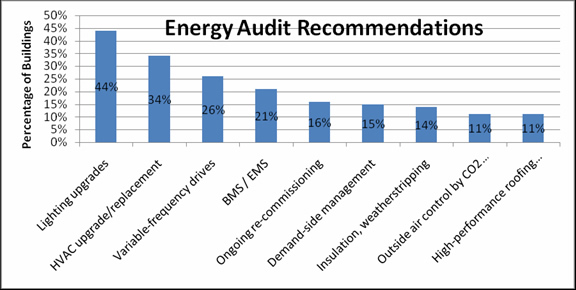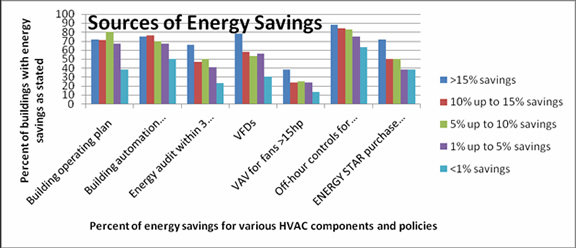by Rebecca Walker — November 21, 2008 According to a new survey published by FMLink, the Building Owners and Managers Association (BOMA) International, the U.S. Green Building Council (USGBC) and the Association for Facility Engineers (AFE), more and more facility managers are implementing re-commissioning and energy audits to measure and improve their building’s energy performance.
The survey, which was sent to more than 30,000 individuals, also found that most energy savings successes were the result of aggressive low-cost operational strategies rather than major capital projects. However, such capital projects are one of the big items scheduled for action in the coming year.
“With the ever-growing need to reduce our collective carbon footprint and deal with the skyrocketing costs of energy, it is critical that we better understand not only what our building owners and facility managers are doing about this, but also to see which actions have made the greatest impact,” said Peter Kimmel, an architect and IFMA Fellow, as well as the Publisher of FMLink. “I was very delighted to see that so many respondents are already doing so much to conserve energy wherever possible. There certainly are many more building professionals doing more than ever before.”
Other key findings include:
- Survey responses indicate that more than three quarters of the buildings greater than 50,000 sq. ft. had Building Automation Systems (BAS). 87% of those with more than 600,000 sq. ft. had BAS. Most of the respondents who experienced a greater-than-5% energy savings over the past two years had implemented a BAS.
- Respondents who underwent building re-commissioning two or more times a year had significantly more energy savings over the past two years than those who had not.
- 41% of building operating plans included a professionally-developed energy-strategies staff education program. Just under 12% of respondents said they plan to implement such a plan in the next 12 months.
- 59% of respondents have occupancy sensors in their general office space.
- 9% of the buildings had some form of green certification (mostly ENERGY STAR or LEED). However, a majority said they plan to obtain some aspect of green certification in the future.
- 73% of all buildings greater than 50,000 sq. ft. have had an energy audit. Conversely, 63% of those under 25,000 sq. ft. did not have an audit. 86% of the audits were done in the past five years, 64% in the past three years; and 30% were completed in the past year.
For respondents who had an energy audit, the most common recommendations to come from the audit were lighting upgrades (with more than 45% for respondents with buildings greater than 50,000 sq. ft.), and HVAC upgrade/replacement (chiller, air handling unit, boiler, pumps, outside air), which were mentioned by 34% of respondents. For those with buildings smaller than 50,000 sq. ft., weather stripping and insulation recommendations were frequently mentioned. Overall, more individual recommendations related to HVAC systems than any other building system.
Overall, the respondents averaged energy savings of 5-10% over the past two years. 57% of those respondents measured their savings through the money expended on utilities, energy consumed or their ENERGY STAR score.
66% of respondents indicated that they do not have a green lease; however, 55% of respondents do provide their tenants with an operations manual that includes good energy management practices.
Most respondents showed an excellent understanding of nearly all energy-related concepts, with a few exceptions that often fall in the bailiwick of professional engineers. It also became clear that many building professionals would benefit from general assistance in determining if their buildings are indeed “green” or what they have to do to make them green.
The largest differences in reported energy savings came from those who have had an energy audit over the past three years, those who re-commission at least twice a year, those who have implemented ENERGY STAR rules of procurement, those with variable-frequency drives (VFDs), and those with lighting sensors.
When asked what they plan to upgrade, install or replace over the next year, respondents said
- Minor repairs or corrective maintenance (37%)
- HVAC equipment (30%)
- VFDs (23%)
- Ongoing recommissioning (21%)
“From offering the latest industry education to implementing energy audits to applying effective low-cost operational strategies property professionals are doing what it takes to save energy and reduce costs,” said BOMA International Chair and Chief Elected Officer Richard D. Purtell, RPA, portfolio manager, Grubb & Ellis Management Services, Inc. “We were pleased to be a part of this important survey and look forward to continuing to help our members and the commercial real estate industry at large improve energy performance.”
The survey was co-sponsored by McQuay International, Performance Roof Systems and Philips Lightingthree companies that are committed to reducing carbon emissions.
The survey research was planned, coordinated and analyzed by Peter Kimmel, AIA, IFMA Fellow, the Publisher of FMLink and a former facility manager. The charts below provide additional context.
Energy-Savings Survey Results: Accompanying Charts produced by FMLink.
 |
The above chart shows, as expected, that fewer buildings have sensors in their restrooms as the percentage of restrooms with sensors increases for each building. Surprisingly, there are many buildings with a high percentage of restrooms with sensors at the right side of this chart, indicating that there are many facilities that try to implement some energy savings initiatives to the fullest extent possible.
 |
The above chart shows that there has been a clear trend of more audits in the most recent years.
 |
Note in the above chart that most of the energy audits’ recommendations related to HVAC systems.
 |
By looking at the buildings that have had re-commissioning at least twice a year there are clear indications that they are likely to have considerable energy savings (the height of each column trends downward from left to right). There were no such trends for re-commissioning when done once a year or less. When there was no re-commissioning the trend goes upwards to the right, indicating that one is less likely to experience energy savings. Note: The percentages of energy savings represent savings over the most recent two-year period.
 |
When looking at the first two sources in the above chart (building operating plan and BAS) one sees that the savings were flat for all but the last column, which was considerably lower than the others; this means that with these two sources, one is likely to have savings but not necessarily a lot. The remaining five sources have a downward trend, indicating that it is much more likely to have more savings as a result of their implementation. Note: The percentages of energy savings represent savings over the most recent two-year period.
About FMLink
FMLink is a comprehensive, online facilities management publication; it includes over 12,000 pages of news and featured articles, including survey and benchmarking data, events calendars, recent and pending regulations, best practices, checklists, magazine articles from many FM publications, discussion forums, job mart, vendor directories, and much more to support facilities professionals in their jobs. It also includes a very major section on sustainability. FMLink has 75,000 registered online subscribers, and over the past 12 months had over 600,000 unique visitors. FMLink offers free access through its Web site.
About BOMA International
Founded in 1907, the Building Owners and Managers Association (BOMA) International is an international federation of more than 100 local associations and affiliated organizations. The 17,000-plus members of BOMA International own or manage more than 9 billion square feet of commercial properties in North America and abroad. BOMA’s mission is to enhance the human, intellectual and physical assets of the commercial real estate industry through advocacy, education, research, standards and information. See the Web site for more information.
About USGBC
The US Green Building Council is a nonprofit membership organization whose vision is a sustainable built environment within a generation. Its membership includes corporations, builders, universities, government agencies, and other nonprofit organizations. Since UGSBC’s founding in 1993, the Council has grown to more than 16,700 member companies and organizations, a comprehensive family of LEED green building rating systems, an expansive educational offering, the industry’s popular Greenbuild International Conference and Exp, and a network of 78 local chapters, affiliates, and organizing groups. For more information, visit the Web site.
About the Association for Facilities Engineering (AFE)
AFE is the premier organization for facility engineers and maintenance personnel. The Association unites a large community of likeminded professionals for networking opportunities, knowledge-sharing, and support, as well as offers members a wide variety of educational opportunities, training, and certification for career advancement. AFE maintains this strong community position by serving as the central store for facilities engineers and maintenance professionals to advance their knowledge and skills. For more information, visit the Web site.




